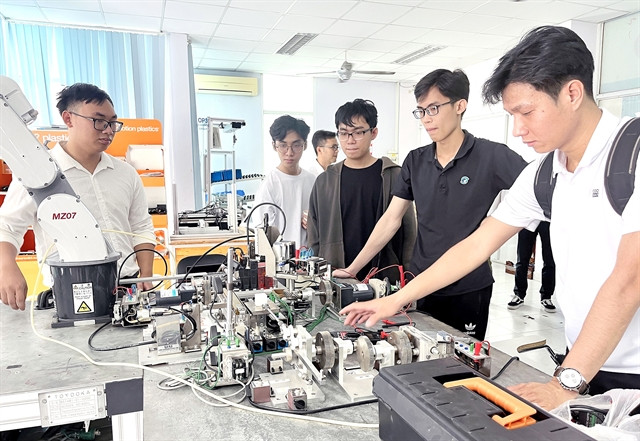Nurturing talents a top priority as Việt Nam envisions itself as future semiconductor hub
Experts believe that Việt Nam has a great opportunity to grow its semiconductor industry with the involvement of multiple leading global technology companies, but it will need ten times the number of engineers.
Identifying talents has been determined as the top priority for the semiconductor industry as Việt Nam pushes for the national strategy to develop the sector.
The country has envisioned itself as a future hub for semiconductor design, packaging and testing with plans until 2030 with a vision to 2050.
However, while this industry is considered the driver for other sectors in the age of technology, the human resource capability in Việt Nam remains modest.
According to the Ministry of Information and Communications (MIC), the workforce demand for information technology (IT) and other digital industries in Việt Nam is estimated at about 150,000 engineers per year.
The country’s actual labour force can only respond to about 40-50 per cent of this figure, while for the semiconductor industry, only around 20 per cent of its labour demand can be met.
Vũ Quang Hùng, deputy director of the Việt Nam Institute of Strategy and Policy for Industry and Trade (VIOIT) said that while the country has long been a part of the semiconductor supply chain, its engagement remains only at the packing and testing stages for several major chip manufacturers, like Intel.
Semiconductors are available in a wide variety, but Việt Nam’s packaging capacity has only been able to respond to simpler types, he added.
According to Đỗ Thị Thúy Hương, an executive board member of the Việt Nam Electronic Industries Association (VEIA), the semiconductor industry involves multiple technical aspects, from production investments to technology processes and updates.
Therefore, while qualified integrated circuit (IC) design engineers are very important, this fast-paced industry also demands a workforce that can also master the semiconductor manufacturing processes.
Experts believe that Việt Nam has a great opportunity to grow its semiconductor industry with the involvement of multiple leading global technology companies.
It is forecast that by the end of 2024, Việt Nam’s semiconductor industry will exceed US$6.16 billion in value, becoming one of the key manufacturing hubs of many global enterprises.
In addition to Samsung, which has chosen Việt Nam as its largest product development centre in Southeast Asia, several Dutch semiconductor companies have begun directing their investments to their Vietnamese facilities.
BE Semiconductor Industries N.V., from the Netherlands, has obtained an investment certificate at Saigon Hi-tech Park with a capital of more than VNĐ115 billion ($4.9 million) in the first phase. The company’s project is expected to enter operation in Q1 of 2025.
Meanwhile, South Korean semiconductor provider Amkor Technology in September increased the capital in its factory in Yên Phong II-C Industrial Park (Bắc Ninh Province) by over $1.07 billion.
In June, the northern province also issued an investment registration certificate to Foxconn Circuit Precision (Vietnam) Co. Ltd. for its $383.33-million factory in Nam Sơn-Hạp Lĩnh Industrial Park.
In July, US Secretary of the Treasury Janet Yellen said during her first visit to Việt Nam that the country has emerged as a critical node in the global semiconductor supply chain.
Việt Nam and the US have also worked together to bolster resilient supply chains, especially in regard to the semiconductor industry, she added.
This is both an opportunity and a challenge to Việt Nam, requiring the country to develop its infrastructure, institutions and human resources to grow and attract investments to the semiconductor industry.
FPT Telecom chairman Hoàng Việt Anh said that while there are only about 5,000 engineers working in 40 semiconductor and chip production companies in Việt Nam, the country has set a plan to increase this figure ten fold by 2030.
Major Vietnamese IT companies including Viettel, Vietnam Posts and Telecommunications Group (VNPT) and FPT are also proactively taking actions to increase their capacity in research, development and production in this sector.
VEIA executive board member Đỗ Thị Thúy Hương said that to quickly nurture high-quality human resources for the workforce, it is essential to connect training institutions and businesses to ensure practical skills in this rapidly evolving industry.






